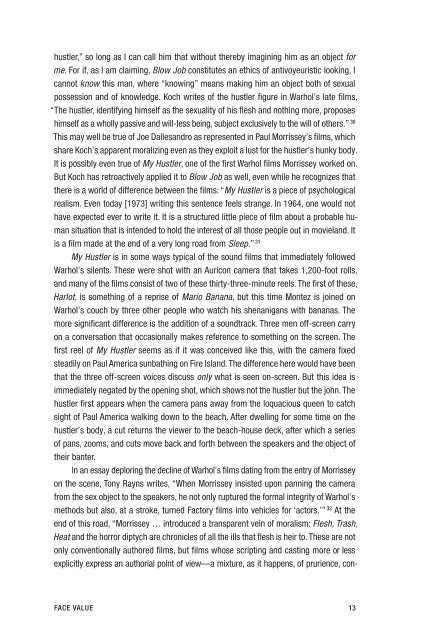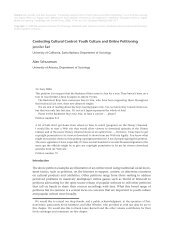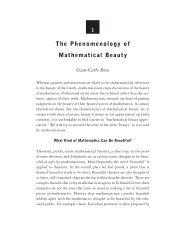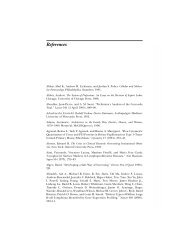Create successful ePaper yourself
Turn your PDF publications into a flip-book with our unique Google optimized e-Paper software.
hustler,” so long as I can call him that without thereby imagining him as an object for<br />
me. For if, as I am claiming, Blow Job constitutes an ethics of antivoyeuristic looking, I<br />
cannot know this man, where “knowing” means making him an object both of sexual<br />
possession and of knowledge. Koch writes of the hustler figure in Warhol’s late films,<br />
“The hustler, identifying himself as the sexuality of his flesh and nothing more, proposes<br />
himself as a wholly passive and will-less being, subject exclusively to the will of others.” 30<br />
This may well be true of Joe Dallesandro as represented in Paul Morrissey’s films, which<br />
share Koch’s apparent moralizing even as they exploit a lust for the hustler’s hunky body.<br />
It is possibly even true of My Hustler, one of the first Warhol films Morrissey worked on.<br />
But Koch has retroactively applied it to Blow Job as well, even while he recognizes that<br />
there is a world of difference between the films: “My Hustler is a piece of psychological<br />
realism. Even today [1973] writing this sentence feels strange. In 1964, one would not<br />
have expected ever to write it. It is a structured little piece of film about a probable human<br />
situation that is intended to hold the interest of all those people out in movieland. It<br />
is a film made at the end of a very long road from Sleep.” 31<br />
My Hustler is in some ways typical of the sound films that immediately followed<br />
Warhol’s silents. These were shot with an Auricon camera that takes 1,200-foot rolls,<br />
and many of the films consist of two of these thirty-three-minute reels. The first of these,<br />
Harlot, is something of a reprise of Mario Banana, but this time Montez is joined on<br />
Warhol’s couch by three other people who watch his shenanigans with bananas. The<br />
more significant difference is the addition of a soundtrack. Three men off-screen carry<br />
on a conversation that occasionally makes reference to something on the screen. The<br />
first reel of My Hustler seems as if it was conceived like this, with the camera fixed<br />
steadily on Paul America sunbathing on Fire Island. The difference here would have been<br />
that the three off-screen voices discuss only what is seen on-screen. But this idea is<br />
immediately negated by the opening shot, which shows not the hustler but the john. The<br />
hustler first appears when the camera pans away from the loquacious queen to catch<br />
sight of Paul America walking down to the beach. After dwelling for some time on the<br />
hustler’s body, a cut returns the viewer to the beach-house deck, after which a series<br />
of pans, zooms, and cuts move back and forth between the speakers and the object of<br />
their banter.<br />
In an essay deploring the decline of Warhol’s films dating from the entry of Morrissey<br />
on the scene, Tony Rayns writes, “When Morrissey insisted upon panning the camera<br />
from the sex object to the speakers, he not only ruptured the formal integrity of Warhol’s<br />
methods but also, at a stroke, turned Factory films into vehicles for ‘actors.’” 32 At the<br />
end of this road, “Morrissey … introduced a transparent vein of moralism: Flesh, Trash,<br />
Heat and the horror diptych are chronicles of all the ills that flesh is heir to. These are not<br />
only conventionally authored films, but films whose scripting and casting more or less<br />
explicitly express an authorial point of view—a mixture, as it happens, of prurience, con-<br />
Face Value<br />
13











